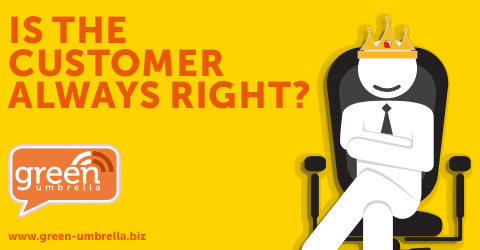The Customer Is Always Right – Discuss!

The Customer Is Always Right – Discuss!

The customer is always right
We all know this age old business cliché don’t we? But is it true, and should it still be the thing that drives everything we do, no matter what?
I ask this question because yesterday a client phoned to complain about something. The thing is, she was wrong. And I could prove it! So what do we do about the conventional wisdom that the customer is always right, even when they’re wrong?
Of course, the customer is the single most important person in your business and without them, there would be no business. They are entitled to behave in whatever way they like and, if they don’t like the service we provide, they can always choose to go somewhere else.
Customer care is paramount
That’s why customer care is paramount for all of us, whether supplying goods or services, and whether the customer is an individual or a B2B client. We are all familiar with the calculations showing that the most cost effective business is done by building excellent customer relationships and creating an environment in which the client buys from us consistently over a period of time. We also know that what customers say about us is important in spreading our reputation so new people come to us through word of mouth referral or testimonials from satisfied people. So there is no disputing the primacy of the customer.
What do we do if the customer is in the wrong?
Having established that; what do we do about the customer who is clearly in the wrong? Factually, logically, we have to say that no, the customer is not always right. But what does that mean? They are still our customer, and as such, they deserve to be treated fairly and well.
I suggest that a more useful way of looking at this is to say that the customer has rights. They come to us for a service, so they have the right to expect that service to be delivered to the best of our ability. They have expectations, and they have the right to want those expectations met. They also have the right to be awkward, or fussy, or indecisive, or wrong. In short, they have the right to do and be anything they wish to be, and they have the right to receive from us professional and high-quality customer service.
The moment we make the distinction between the customer always being right, and the customer having rights, we can set about providing great service while protecting our own interests and theirs as best we can.
Customer rights
I’ve drawn up my suggested ‘bill of rights’ for my clients; in other words, the standards my customers can expect from me.
Customers have the right to:
- Be listened to carefully until we understand their needs, wants and challenges
- Be treated in the way that works best for them
- Understand what the service they will receive is, and what it is not
- Honesty, clarity and communication
- Expect you to value them and seek to exceed their expectations
- Stick to agreed commitments (or advised honestly and openly in the event of an unavoidable problem)
So when my client phoned me – having, as Michael Palin once memorably said, ‘grabbed the wrong end of the stick and beat about the bush with it’ – I didn’t tell her she was wrong. I don’t care about being right; I care about getting the best result for both of us.
She was entitled to her opinion, and I to mine, but I didn’t give her an opinion, preferring to follow a four-stage approach to resolving misunderstandings that I have always found productive:
- Listen: ask questions to help my understanding of the situation as she saw it
- Establish the facts: firstly she needs her version of the facts to be listened to and understood; then it’s my turn
- Explore the options
- Offer a way forward and a choice
Choices
The customer, and you, have a choice to make at the end of this process. This could be, on their part, to continue to believe they are right, or to apologise. On our part, it must be to suggest a way forward that provides the best result for both parties, which may in the last resort be to ‘fire’ your customer. The key is that you both listen; both act as adults and respect each other’s position. If you end up firing your customer, and you can explain unemotionally why it is in the best interests of both, that is your right as the provider of goods or services.
I’ll leave you with the words of the great Brian Clough when asked how he dealt with a player who disagreed with him: ‘I’m happy for a player to disagree with me. What we do is we have a good old discussion about it for twenty minutes or so, and then we both agree I was right.’
As far as customer service is concerned, Clough was almost right. The best result is for the client to feel listened to and understood, and for the chosen course of action to be the best one available. If you’ve really communicated effectively, that solution is likely to be better than if the conversation had never taken place at all.
Don’t make the customer wrong
The customer may not always be right, but we need to avoid the temptation to make them wrong. We can both agree we are right about the next step, confident in the knowledge that we understand each other better than we did before. My client and I continue to work together with more respect for each other and better outcomes for us both. We both have rights and responsibilities. My responsibility is to remove any barriers to me providing great service, so we can both forget about being right, and concentrate on being successful.
Leadership & Management author and trainer
Share this!

